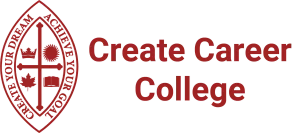SWOT analysis is a valuable tool that can be applied not only by companies but also by individuals to assess various situations. Create Career College recognizes the importance of this strategy, and our students might find it beneficial to delve deeper into this technique to enhance their job search process.
In this article, you will gain a clear understanding of what a SWOT analysis entails, along with access to a SWOT analysis example and a template. We will include personal SWOT analysis examples for students and employees as well.
Table of Contents
What is a SWOT Analysis?
SWOT analysis is a strategic planning tool used by individuals, businesses, and organizations to assess and evaluate situations and make informed decisions. SWOT stands for Strengths, Weaknesses, Opportunities, and Threats. The SWOT analysis involves a comprehensive examination of both internal and external factors that can impact an entity’s performance and success.
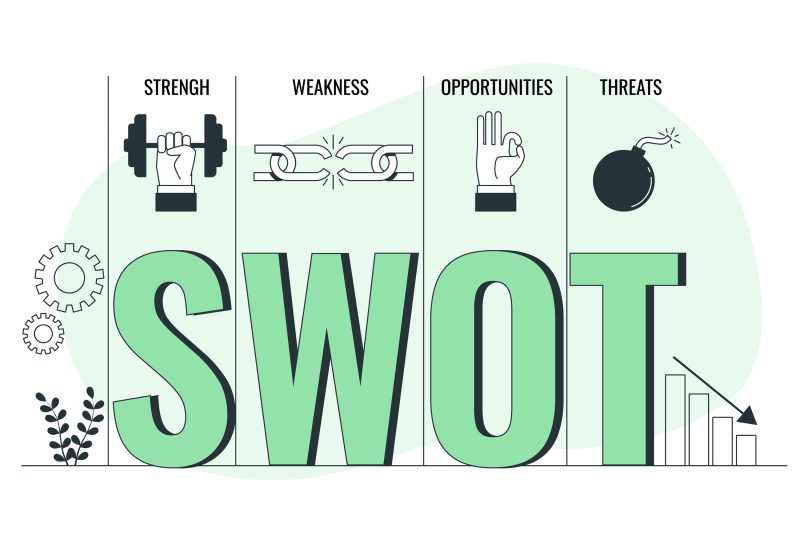
Strengths
These are the internal factors that give an organization or person a competitive advantage. They are all positive factors that contribute to achieving goals and objectives.
Strengths could include things like a strong brand reputation, skilled workforce, proprietary technology, efficient processes, or unique products or services.
Weaknesses
These are the internal factors that represent the areas in which organizations or individuals may be lacking or performing below potential. Weaknesses are negative factors that help an organization or individual understand the aspects they need to improve to avoid potential problems.
Weaknesses could include inadequate funding, outdated technology, lack of expertise in certain areas, or poor internal communication.
Opportunities
These are external factors in the environment that could be exploited to the organization or individual’s advantage. Opportunities are positive factors that an organization or individual can leverage in certain situations or trends to achieve goals.
Opportunities could include the emergence of a new market, advanced technology, changes in consumer preferences, and gaps in the competition.
Threats
These are external factors that could potentially harm the organization or individual’s performance or objectives. Threats are negative factors that organizations have to be prepared to address potential challenges.
Threats could include intense competition, economic downturns, regulatory changes, shifts in consumer behaviour, or disruptive technologies.
Why is SWOT Analysis Important?
Both company and personal SWOT analysis are important. SWOT analysis provides valuable insights and a structured strategic decision-making framework.
Strategic Planning & Decision-Making
SWOT analysis helps individuals and organizations focus on their strengths and opportunities while addressing weaknesses and threats. By understanding the internal capabilities and external factors, decision-makers can make more informed and effective decisions.
Better Resource Allocation
Also, organizations can allocate resources more efficiently, and prevent wasting resources on areas that are less likely to have positive results. Better resource allocation can increase the chances of achieving goals by aligning strategies with the organization’s unique characteristics and the market’s demands.
Risk Management
Addressing weaknesses and threats allows organizations to create contingency plans and risk mitigation strategies. This can help minimize the potential negative impact on the operations.
Competitive Advantage
A business or personal SWOT analysis helps individuals and companies identify areas where they have a competitive edge. They can differentiate themselves from competitors and position themselves as leaders in their field.

How to do a SWOT Analysis?
Doing a SWOT analysis involves a structured process of gathering information and evaluating both internal and external positive and negative factors.
- Define the objectives of the SWOT analysis
- Gather information on internal (Strengths and Weaknesses) and external (Opportunities and Threats) factors
- Create the 4-quadrant matrix
- Analyze each item and prioritize the most important factors in each quadrant
- Develop strategies to leverage strengths and opportunities, and mitigate weaknesses and threats
- Set actionable steps with specific timelines and responsible parties
- Regularly track progress and adapt strategies as needed
How to Act On the Results?
Acting on the results of a SWOT analysis is a crucial step in translating the strategies into actions. Here is a guide on how to effectively act on the results of the business or personal SWOT analysis.
- Review the items identified in the SWOT analysis and prioritize the actions.
- Create detailed action plans to outline specific steps, responsibilities, timelines and resources.
- Leverage strengths and opportunities. Mitigate weaknesses and threats.
- Define Key Performance Indicators (KPIs) to measure the success of your action plans.
- Monitor the progress of the action plans and KPIs regularly.
- Learn from successes and failures to refine the strategies in the future.
SWOT Analysis Example
Sharing some examples could make it easier for readers to understand the SWOT analysis.
SWOT Analysis Example for a Supermarket
The following is an example of a SWOT analysis for a supermarket.
Strengths
- Prime Location: The supermarket is situated in a densely populated area with high foot traffic, making it easily accessible to a large customer base.
- Wide Product Variety: The supermarket offers a diverse range of products, including groceries, fresh produce, household items, and even a bakery and deli section.
- Strong Brand Reputation: The supermarket has built a reputation for quality products, friendly staff, and excellent customer service over the years.
- Loyalty Programs: The supermarket offers a loyalty program that encourages repeat customers by providing discounts and special offers.
- Efficient Supply Chain: The supermarket has established efficient relationships with suppliers, ensuring timely restocking and availability of products.
Weaknesses
- Limited Online Presence: The supermarket’s online shopping and delivery services are not as developed as some competitors, potentially missing out on a growing segment of customers.
- Outdated Store Layout: The store’s layout is not optimized for maximizing customer flow and product visibility, leading to possible confusion for shoppers.
- Employee Turnover: There’s a relatively high turnover rate among employees, affecting overall service consistency and product knowledge.
- Inconsistent Fresh Produce Quality: Some customers have raised concerns about the freshness and quality of certain fresh produce items.
- Lack of Specialty Items: Competitors in the area offer a wider selection of international and specialty products that the supermarket currently doesn’t carry.
Opportunities
- Online Expansion: Investing in a robust online shopping platform and expanding delivery services could tap into the growing demand for convenient shopping options.
- Health and Wellness Trends: Introducing a larger selection of organic, gluten-free, and locally sourced products could attract health-conscious consumers.
- Community Engagement: Partnering with local producers and hosting community events could strengthen ties with customers and increase brand loyalty.
- Private Label Brands: Developing high-quality private label products could increase profit margins and differentiate the supermarket from competitors.
- Eco-Friendly Initiatives: Embracing sustainability practices such as reducing plastic usage and offering reusable bags aligns with consumer preferences and demonstrates social responsibility.
Threats
- Intense Competition: Other supermarkets and convenience stores in the vicinity pose a threat to market share and customer loyalty.
- Economic Downturn: During economic downturns, customers might cut back on discretionary spending, impacting sales.
- Online-Only Retailers: The rise of online-only retailers offering convenience and competitive pricing could draw customers away from physical stores.
- Regulatory Changes: Changes in regulations related to food safety, labelling, or health standards could require costly adjustments.
- Rising Operating Costs: Fluctuating energy costs, inflation, and minimum wage increases could negatively impact profit margins.
Based on this SWOT analysis, the supermarket could develop strategies such as enhancing its online presence, improving store layout, investing in employee training and retention, introducing more specialty items, and adopting sustainable practices. Regularly reviewing and updating the SWOT analysis will ensure that the supermarket remains responsive to changes in its internal and external environment and continues to thrive in a competitive market.
SWOT Analysis Example for Students
Here is the SWOT analysis example for a web design student.
Strengths
- Creativity and Design Skills: The student has a natural flair for creative design and is skilled in using graphic design software.
- Passion for Web Design: The student is genuinely enthusiastic about web design and stays updated with the latest design trends and technologies.
- Portfolio of Projects: The student has already completed several web design projects, showcasing a range of design styles and concepts.
- Quick Learner: The student has a proven ability to quickly grasp new concepts and tools, making them adaptable to evolving technologies.
- Good Communication Skills: Strong communication skills help the student effectively understand and convey client requirements and collaborate with team members.
Weaknesses
- Limited Coding Knowledge: The student’s proficiency in coding languages like HTML, CSS, and JavaScript is relatively basic, which may limit the complexity of designs.
- Time Management: Balancing academic commitments, projects, and personal life is a challenge, leading to occasional project delays.
- Lack of Professional Experience: The student has yet to gain professional experience, which could impact their ability to understand and meet client expectations.
- Limited Networking: The student hasn’t actively engaged in networking opportunities within the web design industry.
- Critique Handling: The student struggles with receiving and implementing feedback, which could hinder growth and improvement.
Opportunities
- Online Learning Resources: Taking advantage of online tutorials and courses can help student improve their coding skills and expand their design repertoire.
- Internship or Freelance Opportunities: Gaining hands-on experience through internships or freelance projects can provide valuable real-world exposure.
- Industry Events and Workshops: Participating in workshops, conferences, and design meetups can facilitate networking and learning from industry experts.
- Building a Strong Portfolio: The student can continue building a diverse portfolio by undertaking personal projects and collaborations.
- Collaboration with Developers: Partnering with skilled developers can help bridge the student’s coding knowledge gap and produce more complex designs.
Threats
- Rapid Technological Changes: The web design field evolves quickly, and failure to keep up with new tools and techniques could lead to obsolescence.
- Competition: The web design industry is competitive, with many talented designers vying for limited opportunities.
- Client Expectations: Clients often have high expectations; failing to meet these could result in negative feedback and a tarnished reputation.
- Scope Creep: Poorly defined project scopes and changes in client requirements could lead to project delays and dissatisfaction.
- Economic Factors: Economic downturns could lead to reduced demand for web design services as businesses cut discretionary spending.
Based on this SWOT analysis, the web design student could consider strategies such as taking online coding courses to enhance their skills, seeking internships or freelance projects to gain practical experience, actively participating in industry events to network, practicing effective feedback reception, and staying updated with the latest design trends. Regularly reviewing and revising this SWOT analysis can guide the student’s ongoing development and help them navigate their path in the web design industry.
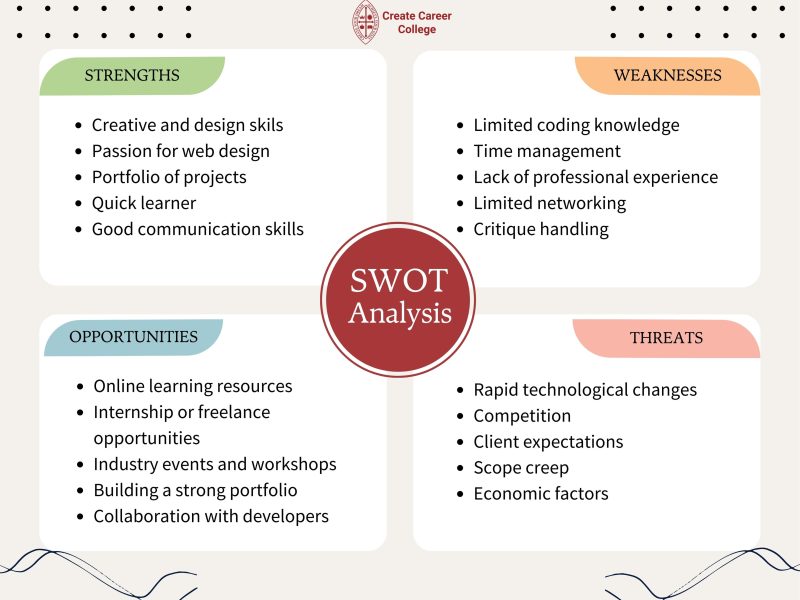
SWOT Analysis Example for Employees
Here’s an example of a SWOT analysis for an accounting employee in an accounting firm.
Strengths
- Advanced Financial Knowledge: The employee possesses a deep understanding of accounting principles, tax regulations, and financial reporting standards.
- Attention to Detail: They consistently demonstrate meticulous attention to detail, which is crucial for accurate financial reporting and analysis.
- Efficient Time Management: The employee effectively manages their workload, consistently meeting deadlines even during peak periods like tax season.
- Strong Analytical Skills: They excel in analyzing financial data, identifying trends, and providing valuable insights to clients and the firm.
- Client Relations: The employee builds strong relationships with clients through clear communication, responsiveness, and personalized service.
Weaknesses
- Limited Technology Adoption: The employee is less comfortable with certain advanced accounting software and tools, which could hinder efficiency.
- Delegation: They often hesitate to delegate tasks, which could lead to unnecessary workload stress during busy periods.
- Networking: The employee tends to focus on their work and may miss out on networking opportunities within the firm and the industry.
- Public Speaking: Delivering financial presentations or explaining complex concepts to clients can sometimes be challenging for the employee.
- Negotiation Skills: They struggle with negotiation skills during client discussions, which could impact the firm’s ability to secure favourable terms.
Opportunities
- Technology Skill Enhancement: Investing time in training for advanced accounting software and tools can improve efficiency and adaptability.
- Professional Development: Attending workshops on negotiation, public speaking, and leadership could bolster the employee’s skills.
- Mentorship: Seeking guidance from experienced colleagues could provide insights into successful delegation and networking strategies.
- Client Consultation Training: Improving negotiation skills and the ability to explain financial concepts can enhance client interactions.
- Cross-Functional Collaboration: Collaborating with other departments within the firm could broaden their skill set and perspective.
Threats
- Automation: Advances in accounting technology may automate routine tasks, potentially reducing demand for certain services.
- Competition: The accounting industry is competitive, and firms with cutting-edge technology and strong client relationships pose threats.
- Regulatory Changes: Changes in tax laws or accounting standards could necessitate quick adaptation to new practices.
- Economic Factors: Economic downturns might lead to decreased client demand for financial services, affecting revenue streams.
- Retention of Top Talent: Fierce competition among accounting firms could lead to the loss of skilled colleagues to other firms.
Based on this SWOT analysis, the accounting employee could consider strategies such as dedicating time to technology training, enrolling in professional development workshops, seeking mentorship from experienced colleagues, practicing negotiation and public speaking skills, and actively collaborating with other departments. Regularly reviewing and updating this SWOT analysis can guide the employee’s career development, helping them leverage their strengths, address weaknesses, capitalize on opportunities, and navigate potential threats within the accounting industry.
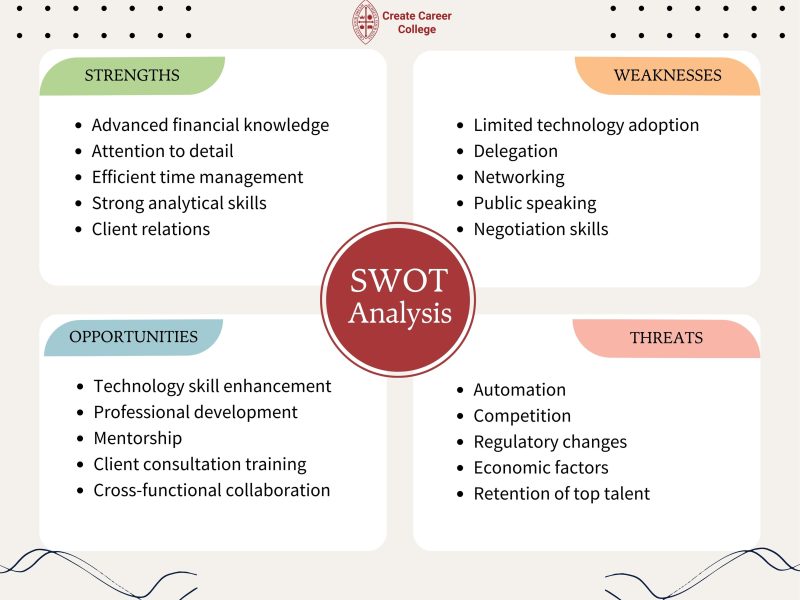
Free SWOT Analysis Template
Create Career College also creates a free SWOT analysis template for our students. We will share the template here.
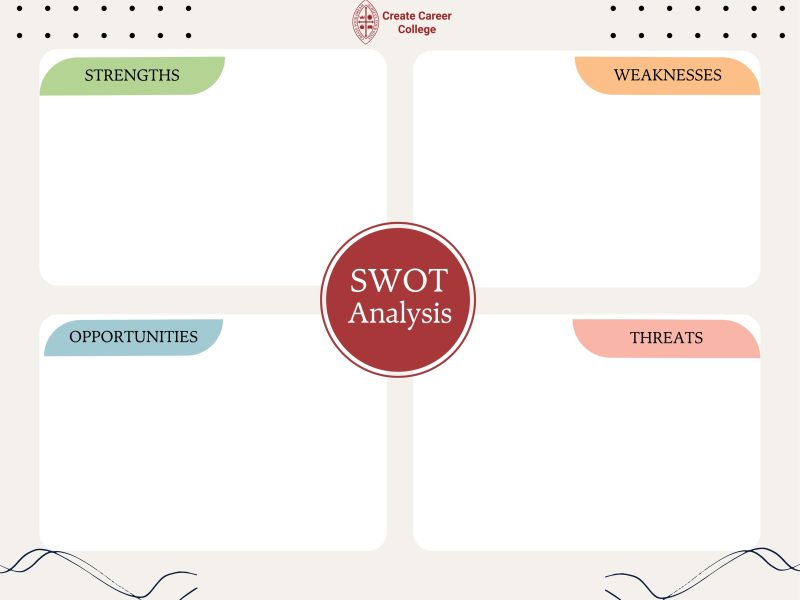
SWOT Analysis: Conclusion
The SWOT analysis is a powerful tool that provides valuable insights for businesses, projects, or individuals. People can use SWOT analysis to evaluate internal strengths and weaknesses and external opportunities and threats. It allows stakeholders to comprehensively understand the current situation and then develop strategic decision-making action plans.
However, a SWOT analysis is not a one-time measurement. It is an ongoing process. Therefore, regularly reviewing and updating the SWOT analysis and the action plans are important.
International students, job seekers, and current employees can visit our example above for a personal SWOT analysis. You can also try to make a SWOT analysis using our free SWOT analysis template.
